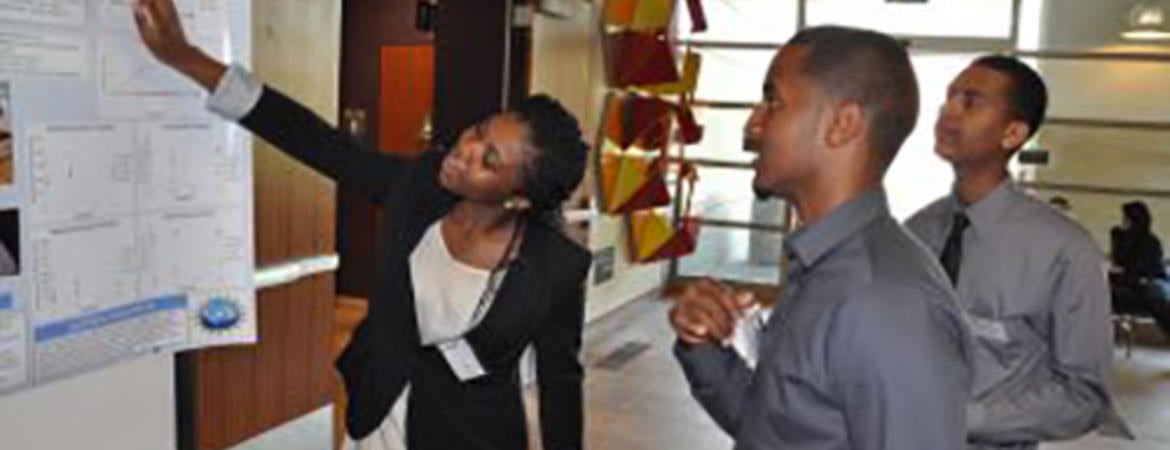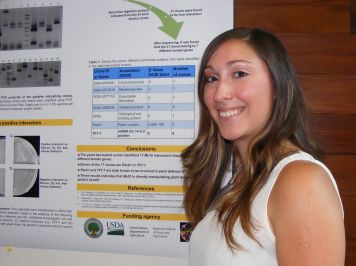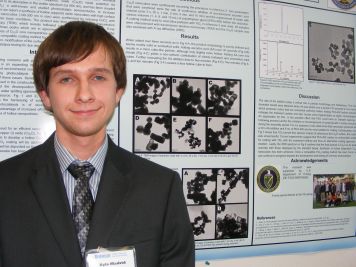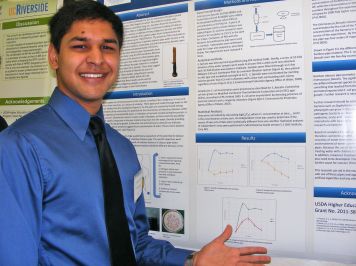
The 2013 Summer Research In Science and Engineering (RISE) Symposium, held at the University of California, Riverside campus on Tuesday, Aug. 27, showcased some of the best undergraduate research being done at the university in the science, technology, engineering and mathematics (STEM) fields.
The symposium marked the end of a ten-week research and academic enrichment program during which the students were engaged in intensive research, working closely with faculty members and research scientists in the College of Natural and Agricultural Sciences (CNAS) and the Bourns College of Engineering.
Twenty-five students gave oral presentations on topics ranging from the effects of biomass burning emissions on climate, to improving plant salinity tolerance, to active transposable elements — or junk DNA — in Aedes aegypti, the yellow fever mosquito.

Stacey Nwagbara (left), who worked in the lab of Sharon Walker in the Bourns College of Engineering, explains her research to fellow-undergraduates.
More than 15 students described their research through posters, on display for much of the day in the lobby of the Genomics Building, covering a large number of topics, including thermal conductivity measurement using the hot-wire method, the survival and growth of bacteria in bamboo tobacco pipe water, and the preparation of hollow nanocubes.
“By all measures, this was a rewarding experience for the students as they begin their scientific careers,” said Richard Cardullo, a professor of biology and the faculty director of the RISE program. “It will be exciting to track the students’ progress and watch them succeed for years to come.”
Now in its third year, the ten-week summer research program is designed for STEM students from varying educationally and/or economically disadvantaged backgrounds. The program’s goal is to increase the number of outstanding students from diverse backgrounds who complete bachelors degrees in STEM fields by getting them acquainted with research.

Marco Garcia (right), who worked in the lab of Richard Cardullo in the College of Natural and Agricultural Sciences, explains his poster to visitors.
RISE was undertaken in coordination with the California Alliance for Minority Participation (CAMP) that was established at UC Riverside in 1994, the STEM Pathway Program that aims at increasing the number of students transferring into STEM fields at UCR and at enhancing support for Hispanic and low-income students pursuing STEM fields of research, and the CNAS Freshman Scholars Program, designed to build learning communities amongst first-year students.
“RISE aims to increase the population of students who pursue master’s and doctoral degrees by strengthening their academic and professional development for admission to colleges and universities nationwide, and especially UCR,” said Nhi Viet Tran, the coordinator for the STEM Pathway Program and one of the main organizers of the daylong symposium.
The participants of the program gained valuable experience in labs at UCR doing research that served as excellent preparation for graduate level research and careers in STEM fields.

The poster session of the symposium drew a large crowd, including faculty and graduate students.
Sanjay Ghai, who will be a sophomore in the fall, worked with Prue Talbot, a professor of cell biology and neuroscience. He strongly recommends the ten-week program to any student interested in pursuing a doctoral degree.
“I liked how the program allowed me to work side-by-side with lab technicians and Ph.D. students,” he said. “I got to see how a lab is structured and I enjoyed the experience of collecting data that I later got to present in a talk at the RISE symposium.”
Mariano Resendiz, who worked with Adam Lukaszewski, a professor of genetics, got an appreciation for the time involved in planning and executing a research project.

“This program is a great introduction to anyone who wants to get into research at an early age,” he said. “My advice to any students interested in this program is to start early because it will reflect well on your curriculum vitae and give you more time to develop your research project.”
Among the students who gave poster presentations on Tuesday were Jennifer Goodrich, Kyle Madrid, and Vivek Patel.
Goodrich, an undergraduate working in the laboratory of Isgouhi Kaloshian, a professor of nematology, presented her work on aphid infestation of tomato plants. Goodrich isolated a previously uncharacterized protein in aphid saliva that breaks down plants defenses.
She believes that her summer research experience will help her future career plans. “I want to work in forensics in a lab setting,” she said, “so I’m interested in learning all the techniques —especially in my field of genetics.”

Madrid is a UCR transfer student who is researching coating methods in particle synthesis. “We’re attempting to synthesize a more efficient photocatalyst — that is, a substance that accelerates chemical reactions in the presence of light — in order to solve energy and pollution problems,” he said.

Patel became involved with the ten-week program through his involvement with the CNAS Scholars Program. His research seeks to characterize bacterial growth in traditional bamboo water pipes commonly used in Laos, where the spread of tuberculosis is a grave concern.
“The aim of my research,” he said, “is to establish guidelines to regulate safe use of these pipes, and apply them to smoking practices in hookah lounges, or with electronic cigarettes and other liquid inhalation smoking apparatuses.
Patel enjoyed working in the lab of Marylynn Yates, a professor of environmental microbiology and the dean of CNAS.
“Our results show significant increases in water pipe bacterial growth compared to control,” he said.